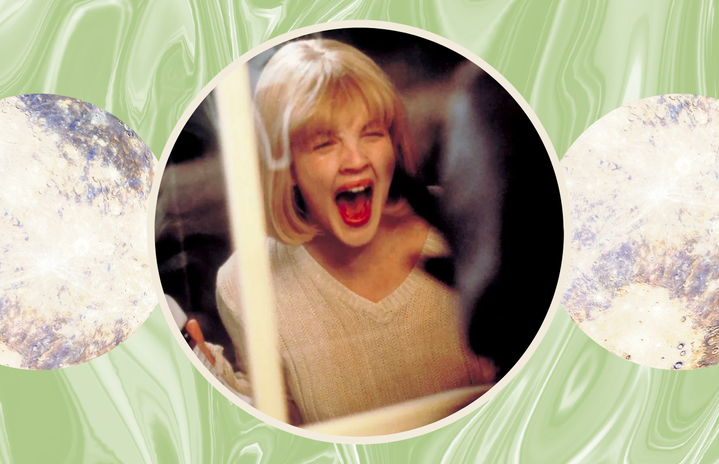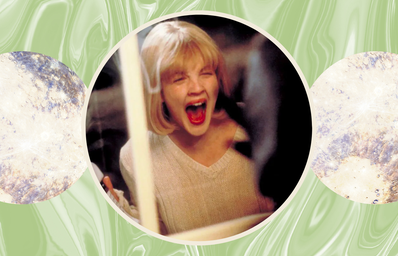It has been socially constructed that the feminine is submissive, shy and nurturing, a symbol of bountiful motherhood. However, the seven films below work to subvert and deconstruct this common misconception about the feminine. The feminine is unbound, and can only be understood as fully human when the feminine subject can terrify, beguile and destroy without constraint.
- Frank Henenlotter’s “Frankenhooker” (1990)
-
Frank Henenlotter’s “Frankenhooker” is a hilarious and compelling take on the classic Frankenstein story. Jeffrey Franken swears to bring his fiance, Elizabeth, back from the dead after she is killed by a lawnmower gifted to her father. He kills a group of ‘prostitutes’ and selects their ‘most desirable body parts’ to recreate Elizabeth. However, once Jeffrey brings Elizabeth back to life and she realizes the morbid reality of where her body parts came from, she is livid! Not only has she been grossly objectified by her fiance, but she has become the physical manifestation of the aftereffects of violence against women. The film ends with a climactic turn of events that draws attention to Jeffrey’s self-deluded hypocrisy and justifies Elizabeth’s final act of brutal vengeance.
- Soska Sisters’ “American Mary” (2013)
-
*TRIGGER WARNING: contains predominant theme of sexual assault*
The Soska twins’ “American Mary” is a revenge tale that champions the transformation of the victim from exploited to power wielding, unlike other revenge films that undermine the personhood of the protagonist by romanticizing their abuse. Mary Mason is a medical school student who is sexually assaulted at a party by one of the doctors under whom she studies. In a twisted turn of events, she becomes an underground surgeon who performs illegal body modification surgeries on an eager crowd of fringe elites. Mary exploits the limits of the patriarchal practice of modern medicine by profiting off of the work it forbids while using her newfound skills and connections as an illegal surgeon to take revenge on her abuser. “American Mary” argues that the categories of permissible and impermissible should depend on choice rather than law, and that exploited femininity is a justifiable cause for masculinity effaced beyond recognition.
- Sam Raimi’s “Drag Me to Hell” (2009)
-
Christine is a loan officer seeking a promotion from her boss, who feels that she isn’t fit for a promotion until she can make some “tough decisions” regarding the loans. When an elderly woman named Ganush enters the office after being evicted from her home, Christine attempts to display her ability to make “tough decisions” by denying her a loan, despite Ganush begging her on her knees for one. “Drag Me to Hell” can be read as a tragic tale of women not supporting women, where Christine, our protagonist, champions economy and male validation over solidarity between herself and another woman. Thus, Ganush becomes representative of the anger of women who have been exploited, shunned, and abused by other women in the name of men. The final climactic scene of the movie serves as a reminder that the consequences of denying solidarity to the women around you are more grave than something as mundane as not receiving a promotion.
- Tomas Alfredson’s “Let the Right One In” (2008)
-
“Let the Right One In” is the quintessential vampire love story about Oskar, a twelve-year old boy who is incessantly bullied at his school, and his new neighbor Eli, who mysteriously appears around the same time a local string of murders begins. Though Eli attempts to deny Oskar’s friendship, she becomes attached to Oskar and even trusts him with her biggest secret: that she is a vampire. Though the viewer witnesses Eli murder throughout the film in order to feed herself, it is not until the very end of the movie that we experience the depths of Eli’s rage, emphasizing the difference between quotidian murders and provoked rage, meaningless killings and a targeted, authentic bloodlust for revenge. Eli accomplishes all of this without drawing any great attention to herself, preserving her identity as a vampire by hiding away and playing into her physical appearance as a young girl, all while destabilizing the tiresome trope that all little girls are inherently gentle, benign beings.
- Takashi Miike’s “Audition” (1999)
-
Notoriously known as a film with a brutally violent ending, Miike’s “Audition” is a model example of male conceit meeting unrelenting feminine brutality. Aoyama is a widower who is encouraged to re-enter the dating market by his son Shigehiko. In order to do so, he hosts a fake audition for a role that does not exist. In the following scene, we watch Aoyama and his friend objectify and laugh at the auditioning women between themselves. However, when Aoyama sees Asami, in her all white virginal outfit, he imagines her fulfilling the script of a feminine ideal and desires her. Aoyama does not know that Asami has other ideas for their “love story,” which do not include a submissiveness to his whims. In the latter half of the film, we watch as Asami becomes a glorious and brutal representation of a subversion of the female script of submission and victimhood, making a mockery of the masculine understanding of what the restraints of femininity are and creating her own.
- Alex Garland’s “Ex Machina” (2014)
-
Considering our present moment is saturated with concerns and fears about the power and potential of AI software like ChatGPT and Midjourney, I caught myself reminiscing about Garland’s “Ex Machina”. This film is a fantastic tribute to the pitfalls of male narcissism. It reinforces Simone de Beauvoir’s 1949 seminal feminist text, “The Second Sex,” where she asserts that “one is not born, but rather becomes, a woman.” Inventor Nathan Bateman creates “Ava,” a physically attractive AI robot who Caleb Smith, a programmer, is tasked with speaking to daily in order to collect data for a Turing test. A Turing test assesses a machine’s capacity to display an intellect indistinguishable from a human’s own. Ava plays into the femininity that Caleb and Nathan expect from her by dressing in delicate floral patterns and flirting with Caleb. Caleb’s and Nathan’s expectations of Ava, and what her limits are, leads to the brilliant final quarter of the film: Ava’s tactful manipulations and her epic portrayal of liberation and an unapologetic autonomy.
- David Cronenberg’s “The Brood” (1979)
-
“The Brood” is a beautiful, mesmerizing portrayal of the woman’s body as a vessel which gives birth to rage itself. Nola and Frank are a married couple undergoing some serious marital difficulties. After Nola has a mental break, she is admitted into Dr. Raglan’s experimental psychiatric facility. Dr. Raglan and Frank serve as foils to Nola— their plainness emphasizes the intensity of her anger. While horror has historically focused on the male body as the ideal subject of the villainous, the monstrous, the unhinged and the terribly violent, “The Brood” subverts this commonplace interpretation by reminding its viewers that all rage is born from the mother’s womb. This birthing process alienates, perplexes and often disgusts the male subject, which is fantastically portrayed in Nola’s relationship with Dr. Raglan and in her final encounter with Frank towards the end of the film. Nola can be viewed as a representation of all the ‘psychotic women’ who are locked away in mental institutions for expressing themselves in ways that men cannot understand. “The Brood” suggests that feminine rage should be protected and cared for, like children are; in this way, it can be harnessed as a means to freedom, hopefully less grim than Nola’s own.
So it can be said that feminine rage is no oxymoron— it is a necessary aspect of the feminine experience that humanizes the feminine. I hope this article has inspired you to reconsider what the bounds of femininity are, and may empower you to a new interpretation of it altogether.

